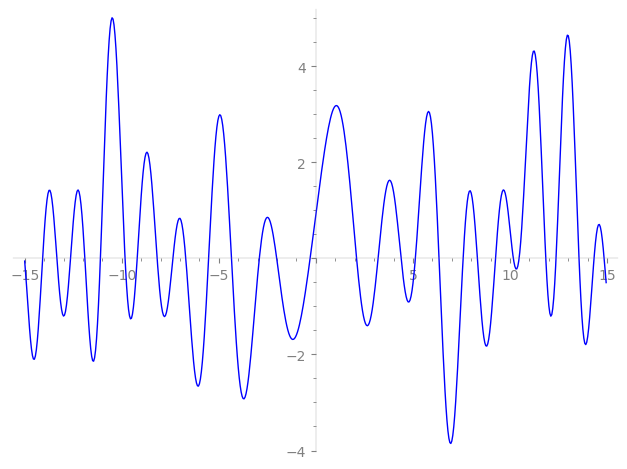| L(s) = 1 | + (1.5 − 2.59i)3-s + (−4.5 − 7.79i)9-s − 22·13-s + (−13 − 22.5i)19-s + (−12.5 + 21.6i)25-s − 27·27-s + (23 − 39.8i)31-s + (−13 − 22.5i)37-s + (−33 + 57.1i)39-s − 22·43-s − 78·57-s + (−37 − 64.0i)61-s + (−61 + 105. i)67-s + (23 − 39.8i)73-s + (37.5 + 64.9i)75-s + ⋯ |
| L(s) = 1 | + (0.5 − 0.866i)3-s + (−0.5 − 0.866i)9-s − 1.69·13-s + (−0.684 − 1.18i)19-s + (−0.5 + 0.866i)25-s − 27-s + (0.741 − 1.28i)31-s + (−0.351 − 0.608i)37-s + (−0.846 + 1.46i)39-s − 0.511·43-s − 1.36·57-s + (−0.606 − 1.05i)61-s + (−0.910 + 1.57i)67-s + (0.315 − 0.545i)73-s + (0.5 + 0.866i)75-s + ⋯ |
\[\begin{aligned}\Lambda(s)=\mathstrut & 588 ^{s/2} \, \Gamma_{\C}(s) \, L(s)\cr =\mathstrut & (-0.991 + 0.126i)\, \overline{\Lambda}(3-s) \end{aligned}\]
\[\begin{aligned}\Lambda(s)=\mathstrut & 588 ^{s/2} \, \Gamma_{\C}(s+1) \, L(s)\cr =\mathstrut & (-0.991 + 0.126i)\, \overline{\Lambda}(1-s) \end{aligned}\]
Particular Values
| \(L(\frac{3}{2})\) |
\(\approx\) |
\(0.9230457527\) |
| \(L(\frac12)\) |
\(\approx\) |
\(0.9230457527\) |
| \(L(2)\) |
|
not available |
| \(L(1)\) |
|
not available |
\(L(s) = \displaystyle \prod_{p} F_p(p^{-s})^{-1} \)
| $p$ | $F_p(T)$ |
|---|
| bad | 2 | \( 1 \) |
| 3 | \( 1 + (-1.5 + 2.59i)T \) |
| 7 | \( 1 \) |
| good | 5 | \( 1 + (12.5 - 21.6i)T^{2} \) |
| 11 | \( 1 + (60.5 + 104. i)T^{2} \) |
| 13 | \( 1 + 22T + 169T^{2} \) |
| 17 | \( 1 + (144.5 + 250. i)T^{2} \) |
| 19 | \( 1 + (13 + 22.5i)T + (-180.5 + 312. i)T^{2} \) |
| 23 | \( 1 + (264.5 - 458. i)T^{2} \) |
| 29 | \( 1 - 841T^{2} \) |
| 31 | \( 1 + (-23 + 39.8i)T + (-480.5 - 832. i)T^{2} \) |
| 37 | \( 1 + (13 + 22.5i)T + (-684.5 + 1.18e3i)T^{2} \) |
| 41 | \( 1 - 1.68e3T^{2} \) |
| 43 | \( 1 + 22T + 1.84e3T^{2} \) |
| 47 | \( 1 + (1.10e3 - 1.91e3i)T^{2} \) |
| 53 | \( 1 + (1.40e3 + 2.43e3i)T^{2} \) |
| 59 | \( 1 + (1.74e3 + 3.01e3i)T^{2} \) |
| 61 | \( 1 + (37 + 64.0i)T + (-1.86e3 + 3.22e3i)T^{2} \) |
| 67 | \( 1 + (61 - 105. i)T + (-2.24e3 - 3.88e3i)T^{2} \) |
| 71 | \( 1 - 5.04e3T^{2} \) |
| 73 | \( 1 + (-23 + 39.8i)T + (-2.66e3 - 4.61e3i)T^{2} \) |
| 79 | \( 1 + (-71 - 122. i)T + (-3.12e3 + 5.40e3i)T^{2} \) |
| 83 | \( 1 - 6.88e3T^{2} \) |
| 89 | \( 1 + (3.96e3 - 6.85e3i)T^{2} \) |
| 97 | \( 1 - 2T + 9.40e3T^{2} \) |
| show more | |
| show less | |
\(L(s) = \displaystyle\prod_p \ \prod_{j=1}^{2} (1 - \alpha_{j,p}\, p^{-s})^{-1}\)
Imaginary part of the first few zeros on the critical line
−9.830187807622395318128480603650, −9.204219592854962955375168092537, −8.177906159312076729411681894531, −7.36565784553269006973898591406, −6.70286024441232755281635274247, −5.52673322623685321328878916635, −4.34929001111113580725694286479, −2.91445358431442396938335986775, −2.01958346474810853171097571869, −0.29796106070280674850463531125,
2.09510523340834369967397111383, 3.20254896310358304500820519513, 4.38849390343872713736224695249, 5.12273017027325649984311164230, 6.34266505967319717829527087006, 7.58279288877201456951900338993, 8.318516202391227996821782381265, 9.251823007726348740135108796656, 10.17092957099179829229765038957, 10.46585338978960106948698527716

